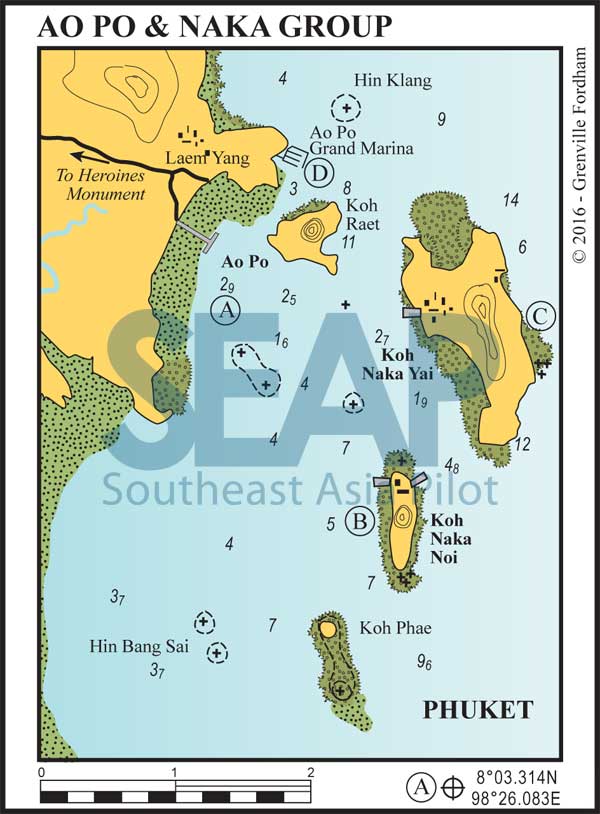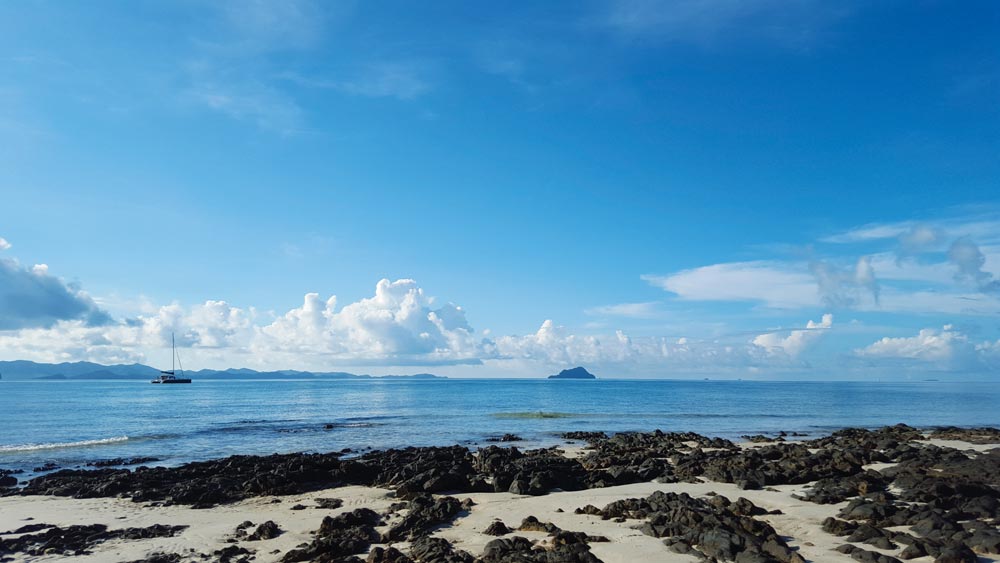
9 miles from Boat lagoon








The safest keel-boat approaches from the north use the passages either side of Koh Raet. In the eastern passage, favour Koh Naka Yai until 300 metres south of Koh Raet before turning northwest into the bay. This is to avoid off-lying rocks detached from the main fringing reef on the south of Koh Raet.
In the western passage stay close to Ao Po Marina entrance and follow the markers between the mainland and Koh Raet. Anchor on the muddy bottom in 3-6 metres.
If approaching from the south, stay close to Koh Naka Yai. The three drying rocks marked on the chart definitely exist, and none of these has any navigation markings or buoys. Some 400 metres long, the new jetty is the main departure point for day boats to the Naka Noi Pearl Farm and for most of the sea canoe operators.
A few local-style shops can be found ashore. There is transport to either Phuket Town or the airport. Fuel, provisions and ice can be bought in the small village.
9 miles from Boat lagoon







The best anchorage is in 5-10 metres to the south of the access jetty on the mid-west coast. Keep well clear of the rocks on the north side of Naka Noi if approaching between Naka Yai and Naka Noi. Keep Koh Phae to port if coming from the south. When heading north from this anchorage, beware of a rock — visible only at very low tides — on the direct line of the passage between Koh Raet and Koh Naka Noi. once clear of the channel, steer well offshore to avoid a second reef, seldom visible at any tide.
Koh Naka Noi is known as Pearl island because of the cultured pearls grown on its northeastern coast. educational demonstrations on pearl farming techniques are given twice daily. There is a seafood restaurant for lunches only at the pearl farm and a souvenir shop selling pearls at a discount. An admission fee is levied for going ashore via the jetty. The beach on the north is great at high tide.
Click to view Thailand photo gallery.

11 miles from Boat lagoon









This pretty anchorage in 5-10 metres on a sandy bottom is a suitable overnight stop in either season. On the northeast coast, two beaches divided by a rocky outcrop afford great swimming together with shady coconut groves.
The silica sand middle beach is all-tide, whilst the north and south are accessible only at high tide. Great for exploring but footwear is essential. The middle beach has the best swimming in the North Bay.
There are three floating jetties on these east coast beaches for easy access ashore and numerous F & B outlets.
A favourite daytime stopover for tour boats from Yacht Haven, Ao Po Grand Marina, Royal Phuket Marina and Boat Lagoon. It is the last, early-afternoon, stop on their return from the caves for up to 100 sea canoe clients.
Beware swimming from the beach on spring low tides, as painful, but not poisonous, cone shells are a seasonal annoyance on the shallow sandy sea-grass bottom.
Despite the many mid-afternoon visitors, it’s an excellent anchorage for the independent yachtsman. It offers a great beach for a barbecue and has a stunning panorama of the dramatic islands of Phang Nga Bay.
12 miles from ao Chalong








This marina, which has all-tide access, has approximately 200 berths inside a rock breakwater. There are deep water berths for up to 25 superyachts.
The approach is best from the south or east to avoid Hin Klang, the acre of rock awash, which is not marked on the northerly approach. The marina entrance is behind a rock breakwater on the southeast side. Approaching the entrance from the east, stay on 260° (and depart on 80°) to avoid the nasty isolated coral head ‘bombies’ off Naka Yai’s north fringing reef.
Some of Phuket’s yachting businesses make this marina their main base of operations due to the proximity of the cruising grounds of Phang Nga Bay. Onshore are a restaurant, a bar, a slipway and hardstand.
